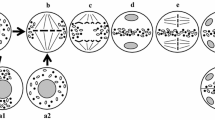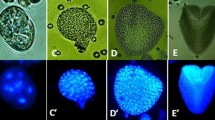Summary
An attempt has been made to manipulate the cytological processes regulating the switch from gametophytic to sporophytic development induced by culturing the microspores of higher plants. Previous studies have indicated that sporophytic development, which leads to the formation of haploid embryos, normally follows the symmetrical division of the microspore rather than the asymmetric mitosis characteristic of normal development. To determine whether symmetry of division is a key factor in the determination of subsequent development, cells were supplied with the antimicrotubule drug colchicine to disrupt elements of the microtubular cytoskeleton believed to be involved in nuclear positioning. The treatment resulted in a highly significant increase in the numbers of cells turning to sporophytic development; further, timed applications indicated that the cells were sensitive to the drug over a 12-h period immediately prior to pollen mitosis. The results suggest that alteration of division symmetry is sufficient to switch the developmental pathway from gametophytic to sporophytic. These findings are discussed in the perspective of current models proposed for the regulation of development in eukaryotic cells.
Similar content being viewed by others
References
Bennett MB, Hughes WG (1972) Additional mitosis of wheat pollen induced by ethrel. Nature 240:566–568
Charne DG, Beversdorf WD (1988) Improving microspore culture as a rapeseed breeding tool: the use of auxins and cytokinins in induction medium. Can J Bot 66:1671–1675
Dickinson HG, Heslop-Harrison J (1971) The mode of growth of the inner layer of the pollen grain exine in Lilium. Cytobios 4:233–243
Dickinson HG, Sheldon J (1984) A radial system of microtubules extending between the nuclear envelope and the plasma membrane during early male haplophase in flowering plants. Planta 161:86–90
Dunwell JM, Sunderland N (1975) Pollen ultrastructure in anther cultures of Nicotiana tabacum: III. The first sporophytic division. J Exp Bot 26:240–252
Dunwell JM, Sunderland N (1976) Pollen ultrastructure in anther cultures of Datura innoxia. I. Division of the presumptive vegetative cell. J Cell Sci 22:469–480
Fan Z, Armstrong KC, Keller WA (1988) Development of microspores in vivo and in vitro in Brassica napus L. Protoplasma 147:191–199
Foroughi-Wehr B, Friedt W (1984) Rapid production of recombinant barley yellow mosaic virus resistant Hordeum vulgare lines by anther culture. Theor Appl Genet 67:377–382
Fransz PF, Ruijter NCA, Schel JHN (1989) Isozymes as biochemical and cytochemical markers in embryogenic callus cultures of maize. Plant Cell Rep 8:67–70
Guha S, Maheshwari SC (1964) In vitro production of embryos from anthers of Datura. Nature 204:497
Hart J, Sabnis D (1976) Colchicine and plant microtubules: a critical evaluation. Curr Adv Plant Sci 26:1095–1104
Horner M, Pratt ML (1979) Amino acid analysis of in vivo and embryogenic anthers of Nicotiana tabacum. Protoplasma 98:279–282
Hu H, Huang B (1987) Application of pollen-derived plants to crop improvement. Int Rev Cyt 107:293–311
Katsuta J, Shibaoka H (1988) The roles of the cytoskeleton and the cell wall in nuclear positioning in tobacco BY-2 cells. Plant Cell Physiol 29:403–413
Katsuta J, Hashiguchi Y, Shibaoka H (1990) The role of the cytoskeleton in positioning of the nucleus in premitotic tobacco BY-2 cells. J Cell Sci 95:413–422
Lichter R (1985) From microspores to rape plants: a tentative way to low glucosinolate strains. In: Sorensen H (ed) Cruciferous crops: production, utilisation, description, vol II. Nijhoff/Junk, Dordrecht Boston Lancaster, pp 268–277
Mineyuki Y, Furuya M (1986) Involvement of colchicine-sensitive cytoplasmic elements in premitotic nuclear positioning of Adiantum protonemata. Protoplasma 130:83–90
Nitsch C (1977) Culture of isolated microspores. In: Reinert J, Bajaj YPS (eds) Plant cell, tissue and organ culture. Springer, Berlin Heidelberg New York, pp 268–278
Pechan PM, Keller WA (1988) Identification of potentially embryogenic microspores in Brassica napus. Physiol Plant 74:377–384
Raghavan V (1977) Patterns of DNA synthesis during pollen embryogenesis in Henbane. J Cell Biol 73:521–526
Raghavan V (1984) Protein synthetic activity during pollen development and during induced pollen embryogenesis in Hyoscyamus niger. Can J Bot 62:2493–2513
Reynolds TL (1984) An ultrastructural and stereological analysis of pollen grains of Hyoscyamus niger during normal ontogeny and induced embryogenic development. Am J Bot 71:490–504
Sax K (1937) Effect of variations in temperature on nuclear and division in Tradescantia. Am J Bot 24:218–225
Sheldon JM, Dickinson HG (1986) Pollen wall formation in Lilium: the effect of chaotropic agents, and the organisation of the microtubular cytoskeleton during pattern development. Planta 168:11–23
Sheldon JM, Willson CE, Dickinson HG (1988) Interaction between the nucleus and cytoskeleton during the pairing stages of male meiosis in flowering plants. Paper presented at the Kew Chromosome Conference III. HMSO London, pp 27–35
Sunderland N, Dunwell JM (1974) Pathways in pollen embryogenesis. In: HE Street (ed) Tissue culture and plant science. Academic Press, London, pp 141–167
Tanaka I, Ito M (1981) Control of division in explanted microspores of Tulipa gesneriana. Protoplasma 108:329–340
Tiwari SC (1989) Cytoskeleton during pollen development in Tradescantia virginiana: a study employing chemical fixation, freeze-substitution, immunofluorescence, and colchicine administration. Can J Bot 67:1244–1253
Traas JA, Doonan JH, Rawlins DJ, Shaw PJ, Watts J, Lloyd CW (1987) An actin network is present in the cytoplasm throughout the cell cycle of carrot cells and associates with the dividing nucleus. J Cell Biol 105:387–395
Venverloo CJ, Libbenga KR (1987) Regulation of the plane of cell division in vacuolated cells: I. The function of nuclear positioning and phragmosome formation. J Plant Physiol 131:267–284
Zaki M, Dickinson HG (1990) Structural changes during the first divisions of embryos resulting from anther and microspore culture in Brassica napus. Protoplasma 156:149–162
Author information
Authors and Affiliations
Rights and permissions
About this article
Cite this article
Zaki, M.A.M., Dickinson, H.G. Microspore-derived embryos in Brassica: the significance of division symmetry in pollen mitosis I to embryogenic development. Sexual Plant Reprod 4, 48–55 (1991). https://doi.org/10.1007/BF00194572
Issue Date:
DOI: https://doi.org/10.1007/BF00194572




